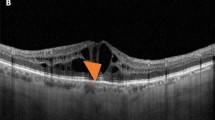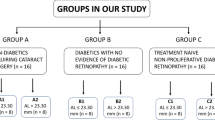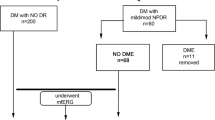Abstract
This presentation covers two topics. First is a basic laboratory study, designed to explore the mechanism for the phenomenon of ‘early worsening,’ in which individuals with type 1 diabetes and early to moderate retinopathy are rapidly placed on ‘tight’ blood glucose control, after which about 10% of these individuals develop a worsening of retinopathy with the appearance of multiple ‘cotton wool’ spots. Our studies on cultured retinal cells used vascular endothelial growth factor (VEGF) production as an index of cellular ischaemia. VEGF production increases substantially when cells are cultured in low oxygen, but VEGF production in these hypoxic cultures decreases when the medium contains a fivefold excess glucose concentration. Cultures with no medium glucose also show increased VEGF production. In the clinical situation, we infer from these results that retinas with early retinopathy have a reduced blood supply and are therefore relatively ischaemic, thus increasing their VEGF production. Adding glucose provides an alternative energy supply, thus reducing the demand for VEGF and hence, reducing the likelihood of ‘early worsening.’ However, reducing the glucose supply to these already compromised retinas further increases their ischaemia and, therefore, the stimulus to produce more VEGF. The second part of this presentation is a clinical exploration of possible reasons for the frequent, wide discrepancy between measured central macular thickness by optical coherence tomography (OCT) and visual acuity in eyes with diabetic macular oedema. I explore the influence of different diseases in which macular oedema appears, the presence or absence, and size, of cystoid cavities; duration of the oedema; age of the subject, different anatomic derangements including epiretinal membranes and disruptions of the photoreceptor layer, and various biochemical and physiological mechanisms.
Similar content being viewed by others
Log in or create a free account to read this content
Gain free access to this article, as well as selected content from this journal and more on nature.com
or
References
The Diabetes Control and Complications Trial Research Group. Early worsening of diabetic retinopathy in the diabetes control and complications trial. Arch Ophthalmol 1998; 116: 874–886.
Diabetic Retinopathy Clinical Research Network, Browning DJ, Glassman AR, Aiello LP, Beck RW, Brown DM, Fong DS et al. Relationship between optical coherence tomography-measured central retinal thickness and visual acuity in diabetic macular edema. Ophthalmology 2007; 114: 525–536.
The Diabetes Control and Complications Trial Research Group. The effect of intensive treatment of diabetes on the development and progression of long-term complications in insulin-dependent diabetes mellitus. N Engl J Med 1993; 329: 977–986.
Lauritzen T, Frost-Larsen K, Larsen HW, Deckert T . Two-year experience with continuous subcutaneous insulin infusion in relation to retinopathy and neuropathy. Diabetes 1985; 34 (Suppl. 3): 74–79.
Kroc Collaborative Study Group. Blood glucose control and the evolution of diabetic retinopathy and albuminuria. N Engl J Med 1984; 311: 365–372.
Chantelau E, Kohner EM . Why some cases of retinopathy worsen when diabetic control improves. Br Med J 1997; 315: 1105–1106.
Smith LEH, Kopchick JJ, Chen W, Knapp J, Kinose F, Daley D et al. Essential role of growth hormone in ischemia-induced retinal neovascularization. Science 1997; 276: 1706–1709.
Thrailkill KM, Quattrin T, Baker L, Kuntze JE, Compton PG, Martha Jr PM . Cotherapy with recombinant human insulin-like growth factor I and insulin improves glycemic control in type 1 diabetes. RhIGF-I in IDDM Study Group. Diabetes Care 1999; 22: 585–592.
Frank RN . Etiologic mechanisms in diabetic retinopathy. Chapter 66 In: SJ Ryan, AP Schachat, CP Wilkinson, D Hinton (eds). Retina, 4th ed. Elsevier: London, 2006, pp 1240–1270.
Kennedy A, Frank RN . The influence of glucose concentration and hypoxia on VEGF secretion by cultured retinal cells. Curr Eye Res, epub ahead of print 15 December 2010; doi:10.3109/02713683.2010.521968.
Aiello LP, Avery RL, Arrigg PG, Keyt BA, Jampel HD, Shah ST et al. Vascular endothelial growth factor in ocular fluid of patients with diabetic retinopathy and other retinal disorders. N Engl J Med 1994; 331: 1480–1487.
Aiello LP, Bursell SE, Clermont A, Duh E, Ishii H, Takagi C et al. Vascular endothelial growth factor-induced retinal permeability is mediated by protein kinase C in vivo and suppressed by an orally effective beta-isoform-selective inhibitor. Diabetes 1997; 46: 1473–1480.
Shweiki D, Itin A, Soffer D, Keshet E . Vascular endothelial growth factor induced by hypoxia may mediate hypoxia-initiated angiogenesis. Nature 1992; 359: 843–845.
Deak GG, Bolz M, Ritter M, Prager SG, Benesch T, Schmidt-Erfurth U . A systematic correlation of morphology and functional alterations in diabetic macular Edema. Invest Ophthalmol Vis Sci 2010; 51: 6710–6714.
Gangnon RE, Davis MD, Hubbard LD, Aiello LM, Chew EY, Ferris III FL et al. A severity scale for diabetic macular edema developed from ETDRS data. Invest Ophthalmol Vis Sci 2008; 49: 5041–5047.
Davis MD, Sheetz MJ, Aiello LP, Milton RC, Danis RP, Zhi X et al. Effect of ruboxistaurin on the visual acuity decline associated with long-standing diabetic macular edema. Invest Ophthalmol Vis Sci 2009; 50: 1–4.
Enoch JM, Van Loo Jr JA, Okun E . Realignment of photoreceptors disturbed in orientation secondary to retinal detachment. Invest Ophthalmol 1973; 12: 849–853.
Hofer H, Carroll J, Neitz J, Neitz M, Williams DR . Organization of the human trichromatic cone mosaic. J Neurosci 2005; 25: 9669–9679.
Schmitz-Valckenberg S, Steinberg JS, Fleckenstein M, Visvalingam S, Brinkmann CK, Holz FG . Combined confocal scanning laser ophthalmoscopy and spectral-domain optical coherence tomography imaging of reticular drusen associated with age-related macular degeneration. Ophthalmology 2010; 117: 1169–1176.
The Diabetic Retinopathy Clinical Research Network. Randomized trial evaluating ranibizumab plus prompt or deferred laser or triamcinolone plus prompt laser for diabetic macular edema. Ophthalmology 2010; 117: 1064–1077.
Campochiaro PA, Heier JS, Feiner L, Gray S, Saroj N, Rundle AC et al. Ranibizumab for macular edema following branch retinal vein occlusin: six-month primary end point results of a phase III study. Ophthalmology 2010; 117: 1102–1112.
Brown DM, Campochiaro PA, Singh RP, Li Z, Gray S, Saroj N et al. Ranibizumab for macular edema following central retinal vein occlusion: six-month primary end point results of a phase III study. Ophthalmology 2010; 117: 1124–1133.
Scott IU, Ip MS, VanVeldhuisen PC, Oden NL, Blodi BA, Fisher M et al. A randomized trial comparing the efficacy and safety of intravitreal triamcinolone with standard care to treat vision loss associated with macular edema secondary to branch retinal vein occlusion: the Standard Care vs Corticosteroid for Retinal Vein Occlusion (SCORE) study report 6. Arch Ophthalmol 2009; 127 (9): 1115–1128.
Ip MS, Scott IU, VanVeldhuisen PC, Oden NL, Blodi BA, Fisher M et al. A randomized trial comparing the efficacy and safety of intravitreal triamcinolone with observation to treat vision loss associated with macular edema secondary to central retinal vein occlusion: the Standard Care vs Corticosteroid for Retinal Vein Occlusion (SCORE) study report 5. Arch Ophthalmol 2009; 12: 1101–1114.
Nguyen QD, Shah SM, Van Anden E, Sung JU, Vitale S, Campochiaro PA . Supplemental oxygen improves diabetic macular edema: a pilot study. Invest Ophthalmol Vis Sci 2004; 45: 617–624.
Gao BB, Clermont A, Rook S, Fonda SJ, Srinivasan VJ, Wojtkowski M et al. Extracellular carbonic anhydrase mediates hemorrhagic retinal and cerebral vascular permeability through prekallikrein activation. Nat Med 2007; 13: 181–188.
Mincione F, Scozzafava A, Supuran CT . The development of topically acting carbonic anhydrase inhibitors as anti-glaucoma agents. Curr Top Med Chem 2007; 7: 849–854.
Genead MA, Fishman GA . Efficacy of sustained topical dorzolamide therapy for cystic macular lesions in patients with retinitis pigmentosa and usher syndrome. Arch Ophthalmol 2010; 128: 1146–1150.
Bearse Jr MA, Adams AJ, Han Y, Schneck ME, Ng J, Bronson-Castain K et al. A multifocal electroretinogram model predicting the development of diabetic retinopathy. Prog Retin Eye Res 2006; 25: 425–448.
Field MG, Elner VM, Puro DG, Feuerman JM, Musch DC, Pop-Busui R et al. Rapid, noninvasive detection of diabetes-induced retinal metabolic stress. Arch Ophthalmol 2008; 126: 934–938.
Frank RN, Glybina I . Macular oedema. In: Dartt D, Besharse JC, Dana MR (eds). Encyclopedia of the Eye, Vol. 3 Oxford, Academic Press: Elsevier, 2010, pp 1–12.
Acknowledgements
All of the work described in this paper was conducted with funding from a departmental unrestricted Grant from Research to Prevent Blindness, New York, NY, USA. The experiments described in ‘The Mystery of Early Worsening’ were conducted several years ago with funding from the Juvenile Diabetes Research Foundation, also in New York. I am indebted for assistance in the experiments in this section from Alexander Kennedy, BS and for assistance in the studies of the second section of this manuscript, ‘The Mystery of Macular Oedema,’ from Ahmad Aref, M.D. and Michael Mequio, M.D.
Author information
Authors and Affiliations
Corresponding author
Ethics declarations
Competing interests
The author declares no conflict of interest.
Rights and permissions
About this article
Cite this article
Frank, R. The Optic UK Lecture: bench-to-bedside adventures of a diabetes researcher: results past, results present. Eye 25, 331–341 (2011). https://doi.org/10.1038/eye.2010.195
Received:
Revised:
Accepted:
Published:
Issue date:
DOI: https://doi.org/10.1038/eye.2010.195
Keywords
This article is cited by
-
The pathogenesis of early retinal changes of diabetic retinopathy
Documenta Ophthalmologica (2012)



